Summary
Summary notes for A-Level Chemistry Unit 3.2.6 - Reactions of ions in aqueous solution (A-level only)
- Course
- Institution
- Book
Summary notes for AQA A-Level Chemistry Unit 3.2.6 - Reactions of ions in aqueous solution (A-level only) by an Imperial College London MSci Chemistry graduate. Notes divided into the following sections: Metal-aqua Ions, The Acidity of Metal-aqua Ion Solutions, Simple Test-tube Reactions of Metal-a...
[Show more]




